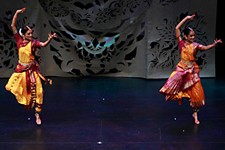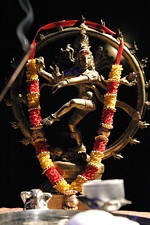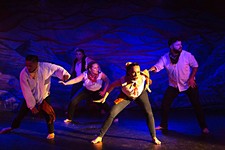Mother-Daughter Dance
Anuradha Naimpally and Purna Bajekal are of two generations, but they share one timeless tradition
By Jonelle Seitz, Fri., March 29, 2013
Purna Bajekal's voice was like a time-lapse image of a flower blooming: fresh, explosive, delicate. All poof and bloom. Pinky-orange.
Until I heard her voice, I'd barely noticed her sitting among the musicians at stage right. I was too intent watching her mother, Anuradha Naimpally, the glimmering yet human figure at center stage, her energy radiating from her slender limbs to infinite but exact points in space. Her face held a slight, coy smile; her eyes seemed to hold all of enlightenment within them. Wearing richly colored, bejeweled garments handmade in India, she stamped her feet in intricate rhythms and shaped her hands in exquisite gestures, bells and bracelets jingling softly. I marveled at her physical beauty and the combination of delicate precision and strength required by Bharata Natyam, the style of classical Indian dance that Naimpally has performed, taught, and promoted under her organization, Austin Dance India, for two decades.
As I was new to Bharata Natyam at this performance last April, my mind raced to capture each detail before surrendering to accept the art's offerings as they came. Then Bajekal's youthful voice, bursting with possibility and clarity, bloomed into the space, rolling off not words or song but staccato syllables that matched the rhythms of her mother's feet. Bajekal was performing the role of the nattuvanar, conducting the musicians' tempo by matching the dancer's rhythms with her voice and a pair of small cymbals. Nattuvangam is essential to the dance but a discrete skill, and Bajekal learned it from her mother, who learned it from her guru in India, whose grandmother was a devadasi, or temple dancer, in the art-rich Tanjavur district of South India. And just like that, Bajekal proved that the 2,000-year-old art is relevant, fresh, 21st century.
Art passed down from generation to generation is not news, you might say. But Naimpally and Bajekal's upcoming performance, Two Generations, One Tradition, sandwiched between Bajekal's arangetram (professional debut) last year and her departure for college this fall, and with Naimpally, at an impossible-to-believe 51, on the threshold of an empty nest, promises a lush microcosm of the artistic and human lineage continuums. Brimming with mother-child themes, the show is also meta-mother: Mother and daughter dancers play various avatars of mother and child, the word "mother" compounded in meaning by the 100 or so generations of women who have embodied the art before them.
Given the exquisiteness of both the art and the performers, it will no doubt be fabulous. In the 2012 performance, when Bajekal rose from the floor to dance alongside her mother, her dancing was as potent as her voice. Daughter and mother have the same large, deeply expressive eyes. Their warm, knowing smiles are similar, though Bajekal's more often seems on the verge of bubbling over into laughter. Bajekal's long arms are her mother's, too, though her jawline curves softly where her mother's makes delicate angles, and Naimpally is an inch or so taller. Dancing side-by-side, they were equals in all measurable senses. However – and here's the bittersweet: The beauty of youth comes only with the rub of another's age – though they wore near-identical costumes, the colors of Bajekal's, inevitably, read as just a touch brighter.
In rehearsal one recent Sunday morning, in a rented studio decorated with pink scarves and paper lanterns, both wore simple practice clothes: printed cotton tunics, black leggings, legwarmers. They wore no apparent makeup, and their wavy dark hair escaped its trappings in wisps. I was reminded that texts on classical Indian dance describe the qualities of the ideal female dancer:
Beauty
Work ethic
Proportion
Intelligence
Agility
Wit
Eloquence
Good memory
Balance
Pleasant voice
Rhythm
Confidence
It seems the dance requires the ideal woman.
Naimpally and Bajekal practice their finale: a fast, rhythmic duet called a tillana, which they have recently choreographed together. The dance exemplifies a dichotomy that makes Bharata Natyam, and specifically these dancers, so enthralling: Their bodies are so graceful, almost delicate, and their lines so precise and refined, and yet they are grounded, weighted to Mother Earth – to whom they say a prayer before each practice, apologizing for stamping on her. Bharata Natyam has ballet's attention to line and grace, modern dance's obsession with gravity, and tap's mind-sharpening rhythms. But when Bajekal does a pirouettelike turn that looks a little too lofty, Naimpally's eyes dart, her lips pursed in slight distaste. "It's a little too balletic." But before the words have left her mouth, Bajekal, smiling, is already dutifully trying again, bending the supporting leg for a more grounded effect.
During that hour of rehearsal, it's the only correction Naimpally gives her daughter. They work as equals, questioning each other about the turn of the head or the number of steps to take, crouching side-by-side over their notebooks to review the choreography. They converse (in English for my benefit, although they also speak Konkani, their family's mother tongue) at a near-telepathic level, impossibly efficient. Often they seem to be two emanations of one meta-dancer. "People say, 'Oh, you look just like her when you dance,'" Bajekal tells me, "and it's because I try to."
For as long as she can remember, Bajekal has watched her mother tell a story about the child Krishna and his mother, portraying both characters in a solo dance. Each time she saw her mother perform it, Bajekal begged her mother to let her play Krishna. "I would always say, I want to do it as a duet," she says, "and now my dreams are coming true, and I am Krishna!" In the dance, the boy Krishna, bored and restless while his mother works about the house, tastes a handful of sand. His mother scolds him until she discovers the entire universe in his mouth, revealing his divinity. "You wanted to be the divine child!" teases Naimpally. But there is a parallel: As Krishna holds the universe in his mouth, the artist – referred to in classical texts as patra, Sanskrit for "pot" – holds the art within herself for a period of time, as a link in the lineage. Naimpally, like Krishna's mother, experiences her child becoming the guardian of something larger than the self.
Both mother and daughter attest that Bajekal was never pushed to become the next guardian of her mother's artistic lineage, but Naimpally is thrilled that they now share a passion, developed on two distinct trajectories, for the art. "I've collaborated with tons of people, professional people, in different genres, but by far my favorite collaborator is Purna. Because she" – Naimpally snaps her fingers – "gets it. And she always has my back onstage." Laughing together, they recall a duet they performed last year in which Naimpally had trouble remembering which way to go. In the wings after one performance, she remembers, "I said, 'Purna, we nailed it, I got it!' And she said, 'Mom, you didn't. The second time we did it, I did the other side so we would look coordinated.' So I say she always has my back because she knows what she's doing and what I'm doing wrong. And I think there's a synergy there that's amazing."
Though synergistic in performance, each has a different relationship with her daily practice. Naimpally has, of late, arrived at a deep intimacy with the steps. Her voice lowers a half-register, her pace slowing in introspection. "Gradually over the years, as I've been teaching and teaching and teaching, there's just something beautiful about these basics steps that I've found. As you do them over and over and over, there's just this reservoir of infinite beauty and depth there." Bajekal says that her focus, at present, is simply to perform the steps as best she can, in a manner faithful to her artistic lineage, though she hopes to one day come upon that reservoir, too. Perhaps it is her search – each patra's search – for that deep, elusive meaning that continues to revitalize the art, any art. In her reaching for the deep, she becomes vulnerable, selfless, open to the universe, and – poof and bloom – we yearn to feel that way, too.
Two Generations, One Tradition runs March 29, 8pm, and March 30, 7pm, at Rollins Theater, the Long Center for the Performing Arts, 701 W. Riverside. For more information, visit www.austindanceindia.com; for tickets, visit www.thelongcenter.org.

















